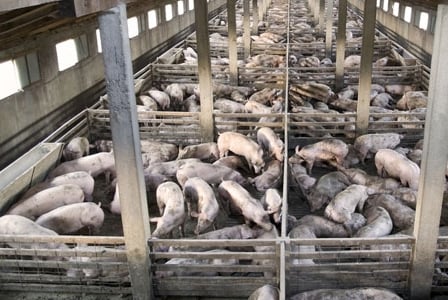
A project that genetically engineered pigs to produce less-polluting pig waste is being halted after failure to find a company willing to bring the animal to market.
The Enviropig project, pigs genetically engineered to generate less-polluting pig waste, may finally be put out to pasture. The major funder, Industry association Ontario Pork, has decided to “redirect its funding [more] to other research projects.”
The project began in 1995 when a team of scientists at the University of Guelph (U of G) developed the Enviropig using genetic material from a mouse and an E. coli bacterium to reduce the amount of phosphorus in the pigs’ feces
“Better for the environment”
The U of G developers based their sales pitch on the premise that a pig that poops less phosphorus would be good for the environment. According to their sales pitch, “Because phosphorus is the major nutrient enabling algal growth that is the leading cause of fish kills resulting from anoxic conditions, and reduced water quality, the low phosphorus manure from Enviropigs has a reduced environmental impact in areas where soil phosphorus exceeds desirable levels.”
“Not so much,” says CBAN
What the developers didn’t foresee was the groundswell of opposition, led by the Canadian Biotechnology Action Network (CBAN), that turned consumers against the very idea of GE pork. No genetically engineered animals have been approved for use in the food supply, but many consumers say in opinion polls that they would be wary of eating them.
What CBAN was clear to point out was that the GE pig is not an environmental solution. Instead of solving the problems brought on by factory operations that house thousands, often tens of thousands, of animals under one roof and spread millions of gallons of liquefied manure on nearby land, the pig itself has been changed.
They say there are many simple solutions available, including a cheap phytase supplement added to animal feed that can reduce phosphorus to about the same amount as produced by the GM pig.
No commercial interest
Though Health Canada approved the Enviropig for reproduction and exportation, applications to both Canadian and US regulatory agencies to approve the Enviropig for human consumption are still pending, making it harder for the U of G team to find a commercial backer.
According to Cecil Forsberg, an emeritus professor of molecular and cellular biology at the university who was a co-inventor of the pig, “It’s time to stop the program until the rest of the world catches up. And it is going to catch up.”
“We’ve done enough research that we feel that if industry is interested they should be able to pick it up,” Forsberg said. He said the university has had some discussions with parties in China, but no deal was reached. (According to U of G figures, China’s population of live pigs in 2007 was 502 million—a considerable market opportunity.)
A sad end for the Enviropigs
A spokesperson for the university said that unless the project finds another source of funding it will save the pigs\’ genetic material—semen and tissue samples—in long-term storage. And sadly (for the 16 Enviropigs at the university at least) the only thing that will be put out to pasture is the project—the piggies themselves will be euthanized.



